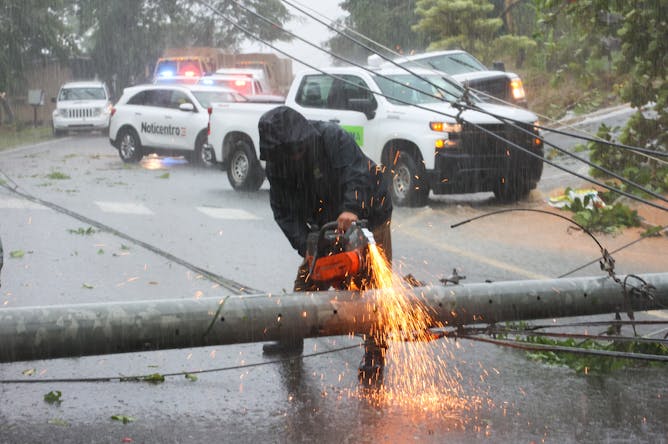|
Puerto Rico has a larger population, about 3.2 million people, than many U.S. states. But it’s hard to imagine, say, Vermont or Idaho struggling to restore its electric grid five years after a major disaster. That was the situation in Puerto Rico when Hurricane Fiona struck this week, almost five years to the day after Hurricane Maria devastated the island in 2017. Now many residents are in the dark again.
Why has this popular tourist destination struggled so much to meet its people’s basic needs? Social scientists Carlos A. Suárez and Fernando Tormos-Aponte point to multiple factors that have hindered Puerto Rico’s recovery from Maria – and some reason for hope from the Biden administration.
Also today:
|

A worker cuts an electricity pole downed by Hurricane Fiona in Cayey, Puerto Rico, on Sept. 18, 2022.
AP Photo/Stephanie Roja
Carlos A. Suárez Carrasquillo, University of Florida; Fernando Tormos-Aponte, University of Pittsburgh
Hurricane Fiona will set back efforts to restore Puerto Rico that date back five years to Hurricane Maria. Two scholars explain how the island’s weak institutions worsen the impacts of disasters.
|
Health + Medicine
|
-
William Hauk, University of South Carolina; Lisa Miller, University of Colorado Anschutz Medical Campus; Wayne Au, University of Washington, Bothell
President Joe Biden’s suggestion that the COVID-19 pandemic is over has led to a backlash among some experts who suggest the comment is premature – and counterproductive.
-
Julie Donohue, University of Pittsburgh Health Sciences; Eric T. Roberts, University of Pittsburgh Health Sciences
Pandemic-related policies made it easier for states to afford to cover more people and made that coverage more stable for millions of Americans who rely on the program for health care.
-
Jennifer Girotto, University of Connecticut
With poliovirus circulating in New York, health authorities worry that pockets of the county with low polio vaccination rates could give the virus a foothold.
|
|
Politics + Society
|
-
Jean Lantz Reisz, University of Southern California
A formal legal investigation would be needed to determine whether the Florida governor and associates violated human trafficking or other laws.
-
Stefan Wolff, University of Birmingham; Tatyana Malyarenko, National University Odesa Law Academy
Vladimir Putin’s televised address to the Russian people is a desperate attempt to raise the stakes over the war in Ukraine.
|
|
Economy + Business
|
-
Joonha Kim, Rice University; Mark Finley, Rice University
A new study shows what it would mean for Europe and China, and why the US might not be too excited about the idea.
-
D. Brian Blank, Mississippi State University
The Fed’s policies are contributing to higher prices and growing recession risks around the world, yet there are good reasons why the US central bank has to keep its focus domestic.
|
|
Ethics + Religion
|
-
J. Eugene Clay, Arizona State University
Christianity is the second-largest religion in Kazakhstan, with 26% of the population practicing the faith. But many Christians, especially in the smaller denominations, have experienced persecution.
-
Christine D. Gonzales-Wong, Texas A&M-San Antonio
A professor of counseling explains how to find therapists and support communities that can help work through these unique challenges.
|
|
Science + Technology
|
-
Svetla Ben-Itzhak, Air University
Crashing the 1,340-pound DART probe into the small moonlet orbiting the asteroid Didymos should redirect its trajectory – and could be a model for how to save Earth in the future.
|
|
Education
|
-
Michelle H. Martin, University of Washington
A scholar of literature for children and young adults shares her insights on how to better connect children with literature and libraries with their communities.
|
|